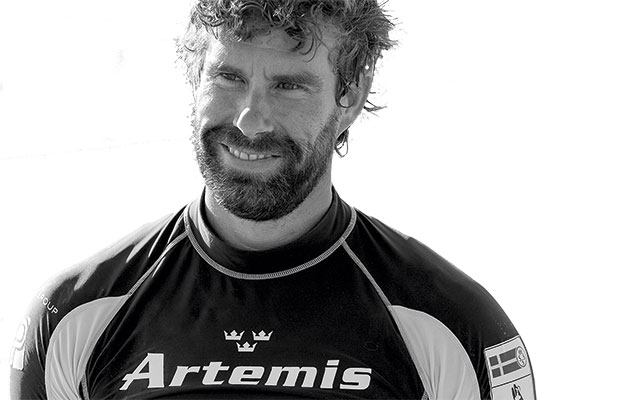Sue Pelling interviews Iain Percy OBE, the Artemis Racing team manager, tactician, and double Olympic and multiple world champion, to get an insight into downwind tactics on fast race boats.
This particular part of the course, coming into Mark 1 on a reach on an AC45, is always one of the most physically demanding and most dangerous parts of the race. Ben [Ainslie] on Land Rover BAR is leading, to windward of us aboard Artemis, and about to bear away round the mark.
The move we are about to make round Mark 1 is called the ‘slingshot’. It is the fastest manoeuvre, with speeds between four and eight knots faster than any other manoeuvre. See 25 seconds into the highlights from ACWS Portsmouth from July 2016 below.
Basically, as you bear away on any catamaran or any fast boat – whether you are foiling or not – you go through what is known as the power zone where the apparent wind is at its strongest. It depends on the type of boat and the conditions but the power zone is normally between 90 and 110 degrees off the true wind direction. Once you are below the power zone, you de-power and take heeling moment off the boat by bearing away; when you are still above the power zone you take heeling moment off by heading up.
What is the AC45? Meet the America’s Cup World Series foiling catamaran
How to outmanoeuvre your opponent at the mark
The boat to windward in the picture is at a lower angle than us. Their goal there is to get onto our wind and then head back up again. This is known as ‘killing someone early’.
In a more conventional boat downwind, it is the boat behind that sits on your wind. With foiling that can’t happen. That is one of the big differences with a boat this fast. To be on the wind of someone downwind, you need to be ahead of them just like you do upwind because the apparent wind is so far forward. In strong winds, if you pull off a proper gybe you will never have someone taking your wind down the run. You can roll another boat but only by overtaking them. Basically, this sort of sailing is about your own tactics and strategy, and executing the move well.
Balancing speed with safety
One of the key things about catamarans in particular, as opposed to fast boats in general, is that they have very little volume forwards – not much bow. This means a catamaran feels like it’s very much in control right up to the moment when it’s not. Although these cats go faster when angled slightly bow-down, if you push it too far you risk tipping it over, so it is all about a balance and a trade off between keeping it flat and safe or more bow-down and quicker.
What to do in the event of a catamaran capsize
Safety in foiling boats, and, indeed, all new fast boats, is something I am very passionate about. Modern technology has led to the development of boats that can go as fast as cars. Loads are high and, during a crash, it is not unusual to go from 45 knots to zero in a second and a half.
The first thing I’d say is really appreciate and respect that speed, and understand that if you are considering a move from, say, an RS200 to a Flying Phantom you are taking a risk. I’m not saying avoid it, but just be aware of the dangers.
The second thing I would advise anyone sailing a cat – or any boat that could potentially trap you beneath a trampoline – is to improve your self-rescue skills. Practise breathing techniques, and the ability to remain calm should the worst happen. This can make a huge difference at a crucial moment. Always wear a helmet, because if you get a knock on the head or fall overboard you are likely to encounter some real damage.
In terms of crew training there is a lot that can be done simply, such as carrying out head counts. I see nothing wrong with reminding yourself and crew of safety protocols and personal responsibilities every time you go out, particularly on a windy day.
See also: America’s cup teams sign up to historic new format – without Emirates Team New Zealand.

IAIN PERCY (40) is one of the most talented and successful sailors in the world. He won Olympic Gold in the Finn in 2000 before teaming up with lifelong friend the late Andrew ‘Bart’ Simpson to win Gold in the Star class in 2008, and Silver at London 2012. He has been involved in the America’s Cup since 2005 and is now leading Artemis Racing’s challenge for the 35th America’s Cup.




